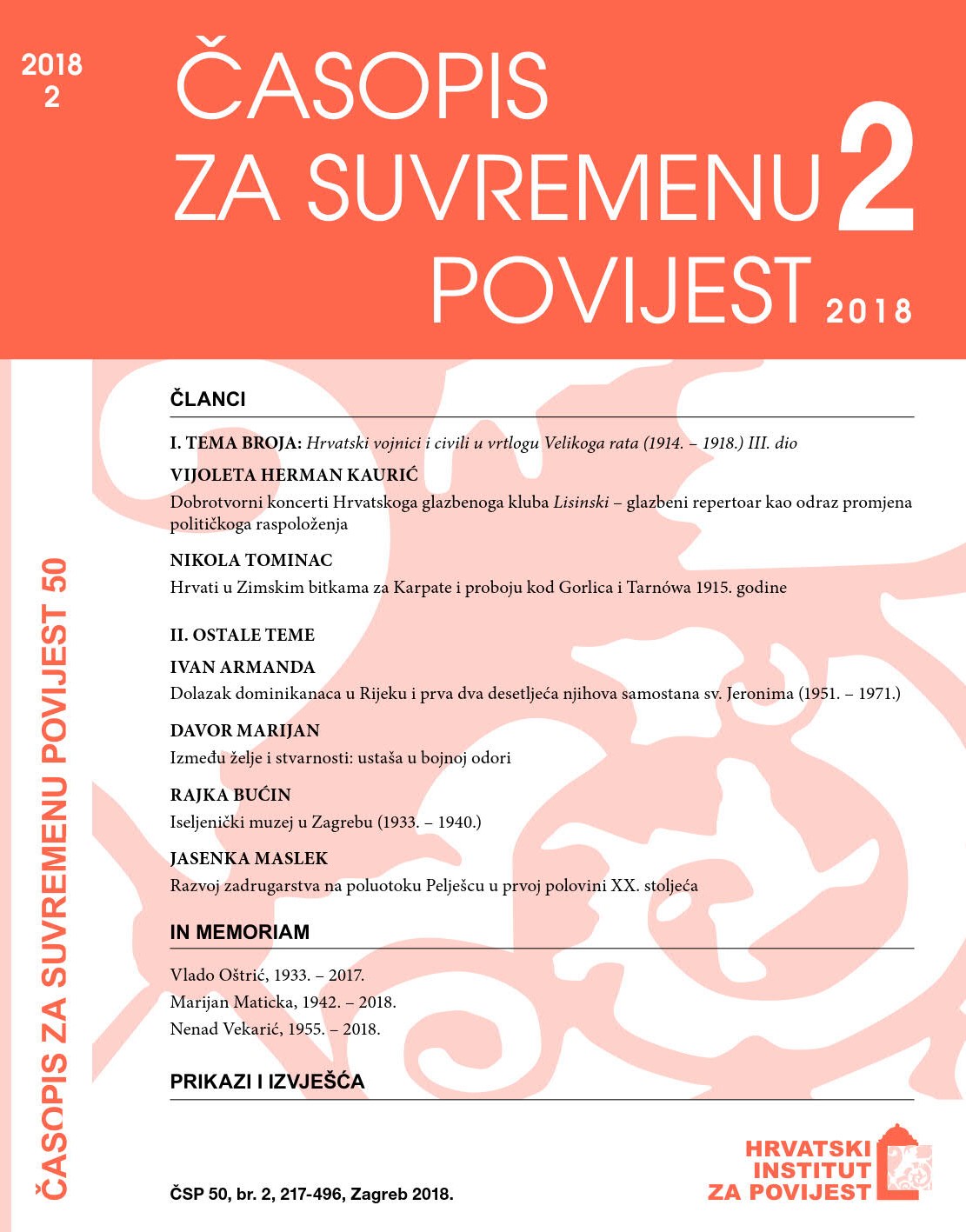Razvoj zadrugarstva na poluotoku Pelješcu u prvoj polovini XX. stoljeća
The Development of Cooperatives on the Pelješac Peninsula in the First Half of the 20th Century
Author(s): Jasenka MaslekSubject(s): History, Economic history, 19th Century, Pre-WW I & WW I (1900 -1919), Interwar Period (1920 - 1939)
Published by: Hrvatski institut za povijest
Keywords: Pelješac; cooperatives; viticulture; rural credit unions (seoske blagajne); capital;
Summary/Abstract: The Pelješac Peninsula was part of the Republic of Dubrovnik from 1333 till its abolition in 1808. This strategically important part of the Republic was, however, removed from the city and isolated. Thus, it was in the nobility’s interests to populate the peninsula with people they could depend upon, safe in the knowledge that the land would be cultivated and, if need be, defended. They found the solution in a specific kind of peasant subjugation, called Pelješac serfdom, where peasants were bound to the land and mostly adopted the grape vine as a long-term crop. Agriculture was always the most important – and practically the only – source of income in this region and, since grape vine was – excepting olives – the only crop that could grow in the hilly and not very fertile soil, all human and material development of this region was closely linked to its cultivation.By the end of the 19th century, the development of agriculture on the peninsula was further slowed by the general economic crisis and the fact that the land had to be cultivated by hand due to the vineyards being located on slopes, and also because the parcels were small and scattered, so that cultivation – and thus production – could not be increased. The necessity of adapting to the new, capitalist economy and commodity-money relations was made easier for the peasants of Pelješac thanks to the agricultural village cooperatives of the Raiffeisen type that began to be established in an organised fashion in Dalmatia on the turn of the century. Rural credit unions (seoske blagajne) simultaneously functioned as both loan and savings banks based on the principle of solidarity, and offered peasants the kind of assistance they needed the most – low-interest and long-term loans without administrative expenses. The first such credit union on Pelješac was established in Kuna in 1898. They were later named loans and savings credit unions (blagajne za štednju i zajmove), and their establishment in other places on the peninsula as well as their longevity show us that they can be considered the most important factor in the peasants’ survival in this region precisely at the time when it was afflicted with phylloxera and when overpopulation was causing mass emigration. The loans and savings credit unions were cooperatives active only in agricultural rural parts of the peninsula because they completely fulfilled their purpose in these areas, and the peasants trusted them fully. Despite being the most widespread branch of economic activity, viticulture didn’t influence this. Instead, the key factor was the cooperative system of mutual assistance that existed among the peasants as well as low membership fees and low deposit protection limits. A chronic lack of capital in all areas of activity stood in the background of everything.Consumers’ and crafts cooperatives were the most common form of peasant cooperative organisation on the peninsula, and most were founded during the first two decades of the 20th century. In rural agricultural areas of Pelješac, they were established under the patronage and with the assistance of rural loans and savings credit unions, which also appeared as creditors of consumers’ and crafts cooperatives during the difficult times of World War I. Like rural credit unions in predominantly agricultural areas, they acted as non-profit associations, without profit sharing, based on volunteering and solidarity as promoted by Raiffeisen, so the great trust of the peasantry in this kind of cooperatives is understandable. However, cooperatives of this kind on Pelješac couldn’t advance agriculture, modernise production, and increase its competitiveness. Because of frequent crop failures and harvests lost due to natural disasters, the low price of wine, and chronic lack of capital in viticulture, funds for the construction of larger cellars or common taverns were lacking. Scarcities meant that the specialisation of cooperatives could not take place in other branches of agriculture, either. This is why producers’ cooperatives were short-lived, and those that survived maintained their basic infrastructure and received equipment thanks to the indirect assistance of the rural credit unions. The primary goal here was to pool working implements, i.e. acquire expensive equipment and enable its communal use, rather than attempting to achieve more standardised and higher quality goods that would be sold together. Apart from this, the shares of producers’ cooperatives were too large and the deposit protection limits significantly surpassed the financial capabilities of those interested. Thus, cooperatives on Pelješac in the first half of the 20th century mostly contributed to the survival of peasant’s holdings, but also to the socialisation and progression of the local peasants in the cultural, educational, and moral sense.
Journal: Časopis za suvremenu povijest
- Issue Year: 50/2018
- Issue No: 2
- Page Range: 391-422
- Page Count: 32
- Language: Croatian

